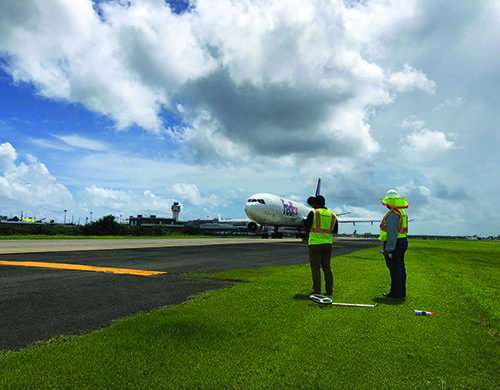As the general public continues to shy away from commercial air travel during the ongoing COVID-19 pandemic, airports are finding new ways to keep their important infrastructure improvements on track. Teams supporting projects in Pittsburgh and Puerto Rico, for instance, learned how to keep projects moving during shutdowns in March. Leveraging remote technologies that allowed personnel to work from home proved pivotal in both cases.
As the general public continues to shy away from commercial air travel during the ongoing COVID-19 pandemic, airports are finding new ways to keep their important infrastructure improvements on track.
Teams supporting projects in Pittsburgh and Puerto Rico, for instance, learned how to keep projects moving during shutdowns in March. Leveraging remote technologies that allowed personnel to work from home proved pivotal in both cases.
PIT Pushes Ahead
Progress continues on the $1.1 billion Terminal Modernization Program at Pittsburgh International Airport (PIT), thanks to the flexibility of key project participants. Even with design and management teams working remotely, the terminal and multi-modal complex parking garage/rental car facilities reached 60% design completion in March and May, respectively.
|
facts&figures Project: Terminal Modernization Program Location: Pittsburgh Int’l Airport Program Cost: $1.1 billion Main Components: New consolidated landside terminal; new multi-modal complex parking garage/rental car facilities Consultants: Gensler + HDR in association with Luis Vidal Architects; Michael Baker International; Burns Engineering; PJ Dick-Hunt; Turner Aviation Software for Design Review: Bluebeam Cloud Technologies: Panzura; Microsoft Azure Virtual Desktop Platform: VMWare Videoconferencing Systems: Skype; WebEx; GoToMeeting; Microsoft Teams; Zoom Project: Taxiway Reconstruction Location: Luis Muñoz Marín Int’l Airport, San Juan Design & Engineering: Kimley-Horn Videoconference Platforms: Microsoft Teams; Skype Cloud Technology: Microsoft Azure |
“Having the right technology to continue working remotely and advancing our projects has been indispensable to the entire airport team and our partners, many of whom are spread out across the country,” says Alyson Walls, communications manager at Allegheny County Airport Authority, which oversees PIT. “Developing advanced technology and creating seamless connectivity for employees, passengers and visitors is a primary goal at PIT. The pandemic thrust that goal into overdrive, and our entire team responded to the challenge.”
As COVID-19 concerns escalated and traffic decreased, PIT officially entered a period of irregular operations on March 12. Just one day later, the entire Terminal Modernization Program design team began working remotely. That included project leaders from the airport and several external consultants: Gensler + HDR, Luis Vidal Architects, Michael Baker International, Burns Engineering, PJ Dick-Hunt and Turner Aviation.
Airport officials knew that opening their new and renovated facilities in 2023 as planned would be difficult, if not impossible, if the pandemic shutdown slowed progress early in the project schedules. However, the teams maintained momentum by using Bluebeam software to review the 60% design sets, which represent 6,000 pages of specifications and drawings for the terminal and multi-modal complex.
“The Pittsburgh project moved along without missing a beat,” reports Matthew McCloskey, director of information technology at Burns Engineering.
After the management team received the final design set for each project (March 9 for the terminal and May 6 for the multi-modal center), program managers uploaded the drawings, specifications and design analysis onto the Bluebeam Cloud Server, where all reviewers could access them and markup documents in live sessions. The Airport Authority first asked subject matter experts to review the documents for two to three weeks, and then opened the Bluebeam sessions to designers.
The size of documents involved taxed some of the team’s home systems, so adjustments were made accordingly. “For the Pittsburgh job, we were working with 8 terabytes of drawings; you cannot get 8 terabytes of data down to somebody using an older PC,” explains McCloskey. “We established protocols so that when teams remote in, they’re on our architecture and don’t rely on the power of local machines.”
Engineering and design teams worked in Panzura, a cloud-based system that caches data in local spots. “Doing so allows personnel in remote offices to access data much faster,” he says.
Teams “came together” on Skype and WebEx calls to answer questions and resolve issues. Designers organized the virtual meetings by discipline—architectural, civil/site, mechanical/electrical/plumbing, information technology/special systems, baggage handling system, etc. The team also used videoconference platforms to provide presentations to senior airport leaders and various stakeholders.
“After the review period, we organized comment reconciliation meetings by discipline to discuss open comments and look for resolutions,” Walls says. “We compiled over 2,000 comments for the terminal, and almost the same amount for the multi-modal complex, into spreadsheets. We arranged several conference calls via GoToMeeting, Microsoft Teams and Zoom, by discipline, to discuss open comments and find a resolution or follow up action.”
It also became essential to manage collaboration remotely. McCloskey notes that creating teams by discipline in Microsoft Teams kept work focused and on track. “Project managers knew their assignments and others on the team and could communicate quickly using instant messengers and other tools to work on documents at the same time,” he says.
 When the time came, Airport Authority personnel developed and used an electronic process to secure bids for switchgear and preconditioned air units for passenger boarding bridges—important enabling projects that needed to stay on schedule.
When the time came, Airport Authority personnel developed and used an electronic process to secure bids for switchgear and preconditioned air units for passenger boarding bridges—important enabling projects that needed to stay on schedule.
Conference calls, cloud servers, collaboration and an extra dose of flexibility kept teams communicating and projects moving forward. “The airport put construction on hold because of the pandemic and economic downturn, but design work on the terminal and multi-modal complex continued virtually,” says Walls.
As the projects continue, ongoing spread of COVID-19 is requiring changes on the fly. “The design and program management teams, along with construction managers, are engaged in a series of post-pandemic design workshops to consider how current and future airport operations and facilities may need to change to address new public health standards and post pandemic realities of air travel,” she explains.
The airport is seeking ways to make more portions of the passenger journey touchless, incorporating new cleaning protocols and adding technology for check-in and security to ensure social distancing and limit face-to-face interactions in the terminal.

Projects Press On in Puerto Rico
Meanwhile in the Caribbean, major airfield improvements are progressing at San Juan’s Luis Muñoz Marín International Airport (SJU).
Aerostar Airport Holdings LLC, the company that operates SJU for the Puerto Rico Ports Authority, managed to juggle the preliminary design stages of its Taxiway H reconstruction project in order to meet crucial FAA funding deadlines.
Pablo Auffant, P.E. Planning & Development director at SJU, notes that partnering with Kimley-Horn and using remote technologies helped the important project stay on track during the airport shutdown.
“Because of the team effort, Aerostar met the aggressive FAA schedule for the FY2020 grant applications based on bids,” says Auffant. “Meeting the FAA schedule puts us in an excellent position to receive a grant for the full amount of the project as part of the CARES Act.”

Aerostar began accepting bids from potential prime contractors for the taxiway project in late April. Design and engineering partner Kimley-Horn had to adjust quickly when SJU was ordered to shut down just a few weeks later.
“The shutdown was a shock for everyone, and it required us to change the way we do things,” shares Eileen M. Vélez-Vega, vice president of Kimley-Horn Puerto Rico. “Normally, we work from an office and hold meetings at the project site.”
 With beginning project design milestones on the various airport projects in March, Kimley-Horn planned to fly in personnel from offices in Fort Lauderdale and Chicago to meet with airport stakeholders and the local design team. “Everyone was set to arrive on March 16, and the executive order to shut down happened March 15,” Vélez-Vega recalls. “No one could travel, but we still had to get our projects done. We had a deadline of May 15 to submit everything to the FAA.”
With beginning project design milestones on the various airport projects in March, Kimley-Horn planned to fly in personnel from offices in Fort Lauderdale and Chicago to meet with airport stakeholders and the local design team. “Everyone was set to arrive on March 16, and the executive order to shut down happened March 15,” Vélez-Vega recalls. “No one could travel, but we still had to get our projects done. We had a deadline of May 15 to submit everything to the FAA.”
FAA had specific timetables for various design submittals, she notes. “We already had strict design schedules to meet deadlines, and we were working with several teams to finalize and review production,” she continues. “The March 16 week was one of our critical milestones to finalize the design.”
The need to coordinate schedules of team members in different time zones quickly emerged as a challenge. Virtual client workshops—long calls with engineering and planning staffs—had to be scheduled well in advance.
“We did everything remotely either through Microsoft Teams or Skype,” explains Vélez-Vega. “We had four to five meetings a day with different team members, and they lasted for hours at a time because we had to coordinate on the final design.”
In all, there were more than 55 employees from more than 10 Kimley-Horn offices working on the projects with dozens of airport stakeholders. Because most team members outside Puerto Rico were in different time zones than the local team, some team members began their workdays at 2 a.m. and others ended at midnight to be on hand for videoconference meetings.
“We could have five separate calls on the same project for different project design elements,” she says. “It was challenging to get everyone on a call at the same time, but we made it work. We had a 24-hour workday.”

A master schedule became crucial to ensure meetings and milestones occurred on time. Additional meetings were added to the schedule that airport stakeholders had helped the design team develop earlier in the year. “Because we were not meeting face-to-face, we needed to meet more often to get through everything,” observes Vélez-Vega. “I appointed a team leader to keep track of these meetings and relied on everyone to watch the schedule on their virtual calendars. If something slipped, it meant we had to make up the time, because the deadline would not change.”
One of the first steps was to create a workable quality control review process. Airport officials received and reviewed design plans first and provided comments to the design team to get everyone on the same page. Then, the design team met to incorporate recommended design changes into the plans.
“We could not meet face-to-face at all, not even in a conference room with one or two people,” she says. “Technology was a lifesaver.”
Fortunately, Kimley-Horn was accustomed to holding virtual meetings. “We normally go to airports to meet with them,” Vélez-Vega explains. “Instead, everyone set up their Microsoft Teams and other virtual platforms.”
The large number of people attending virtual conferences—sometimes up to 40—required extra finesse. “We needed to take attendance to ensure everyone was there,” she notes. “We also learned to take a lot of screenshots and save information continually during the meeting to refer to later.”
Airport officials asked questions by clicking on the hand-raising button in Microsoft Teams, and questions were answered on screen or via the chat function. Like so many other aspects of the project, monitoring questions required a team effort.
“Having that many people on a call is very challenging,” reflects Vélez-Vega. “I needed help monitoring chats and hand raising as I presented. And because Puerto Rico has occasional power outages that cause interruptions to the internet connection, I always needed a backup presenter from our team in case I lost my internet connection. Everyone learned that they needed to be redundant and have several people ready to present in case someone lost their connection.”
Securing construction contractors during the mandated shutdown was difficult, so Aerostar and Kimley-Horn held a virtual workshop for local and U.S. companies to increase participation. They followed up the workshop with online pre-bid conferences and bid openings for interested companies. The first pre-bid conference for the Taxiway H Reconstruction project had more than 30 participants including airport officials, design team members, contractors and subcontractors.
“These meetings took several hours, but we had to do it this way because we couldn’t see each other in person, and the projects’ bidding process had to be completed,” says Vélez-Vega.
Normally, an onsite project tour follows such contractor meetings, but the project team had to get creative because the contractors could not visit the project site. Kimley-Horn field engineer Alberto Matta recorded footage of project areas, and Stan Russell from the Marketing Department edited the recordings into a professional project video. The video presentations provided contractors with a virtual site tour of project areas to help them understand existing site conditions.
Hustle and collaborative effort enabled the airport to submit an FAA grant application by June 15, and put it on track to receive a CARES Act grant.
“Even with the shutdown, we completed the design and construction plans,” reports Vélez-Vega. “The next phase is construction after the grants are received.”
Like SJU and PIT, airports throughout the world are finding alternative ways to accomplish previously rote project tasks. The COVID-19 pandemic is quite literally creating a new normal for managing airport construction. “The new ‘normal’ will probably be a hybrid between virtual and on-site work,” Vélez-Vega predicts. “The process will look a little different than it did before.”
|
10 Tips for Virtual Success Like any new skill, working on airport projects remotely often includes trial and error. Consultants supporting projects for Luis Muñoz Marín International and Pittsburgh International share some of the tricks they’ve learned along the way. 1. Remain Flexible Office hours must change to keep projects moving ahead. Many employees navigating COVID-19 shutdowns are also caring for or homeschooling their children. Some spouses split the workday, with one working 8 a.m. to 5 p.m., and the other working 5 p.m. to 1 a.m. “We had to adapt our hours to reflect this,” says Matthew McCloskey, director of information technology at Burns Engineering. It’s also important to consider the schedules of single and childless employees. With many grocery stores, dry cleaners, etc. abbreviating their operating hours, some team members may need to run basic household errands during the standard business day. 2. Adjust Your Technology Wi-Fi bandwidth quickly becomes an issue when two people work from home and kids are taking part in virtual classes or other online activities. “We had to get creative,” McCloskey says. “We had people get up at 1 a.m. to download large files to work on during the day. Everyone had to adapt.” Eileen M. Vélez-Vega, vice president of Kimley-Horn Puerto Rico, learned to always have a backup presenter lined up to take over in case her Internet connection failed. 3. Involve HR Some people will work constantly when supporting important deadline-oriented projects from home. McCloskey recommends having human resource managers remind employees to “turn off” every now and then. “The tendency is to keep going and going, and never have an end to the workday,” he explains. “While it’s true that you no longer have a commute, that doesn’t mean you should work 15-hour workdays. That’s just going to cause everyone to burn out.” That said, some employees find it difficult to self-motivate and stay on task. Making sure that everyone pulls his or her own weight is crucial to establishing and maintaining a collaborative team culture. 4. Work with Vendors Before the coronavirus pandemic, “zoom” was just a word bubble in comic books. Now we think of it with a capital Z, and use it to videochat with work colleagues. Whatever systems are being used to support projects (Zoom, VMWare desktops, the Panzura cloud, WebEx, Microsoft Teams, etc.), make sure to maximize their effectiveness. “Vendors can help you uncover ways to make virtual work easier,” says McCloskey. 5. Share Resources Virtually With many people working toward the same goal, it’s essential to share resources and critical information across the entire team. “Sometimes we get it in our heads that we need hard copies of everything, but we can share documents virtually and get the job done just as well,” says Vélez-Vega. 6. Think Outside the Box Mandated shutdowns may eliminate physical access to airport construction sites, but they don’t preclude virtual access. Teams can leverage video and virtual reality technology to help consultants and contractors visit worksites without ever stepping out of their homes. 7. Track Progress Vélez-Vega suggests using spreadsheets as a tool to document various project steps and quickly track their completion. She also recommends sharing this information with the entire team, so everyone can see progress happening and remain mindful of remaining steps. 8. Appoint a Project Coordinator Airport projects typically involve multiple phases and large teams of people from many different disciplines. With lots of moving pieces and team members, it is vital to have one person monitoring progress to keep everyone and everything on task. 9. Check the Time Zone Map When scheduling calls and online meetings, take into account the location of team members, and remember that some are stretching their work days to participate. Meetings should be conducted as efficiently as possible to minimize the inconvenience of working odd or extra hours. 10. Maximize Videoconferences Vélez-Vega found it helpful to assign someone to help presenters answer questions and address comments submitted via instant messaging. For especially large groups, she suggests taking attendance to ensure everyone is getting the information they need. She also advises taking screenshots of key material, downloading the meeting files and continually saving information for subsequent reference.
|




